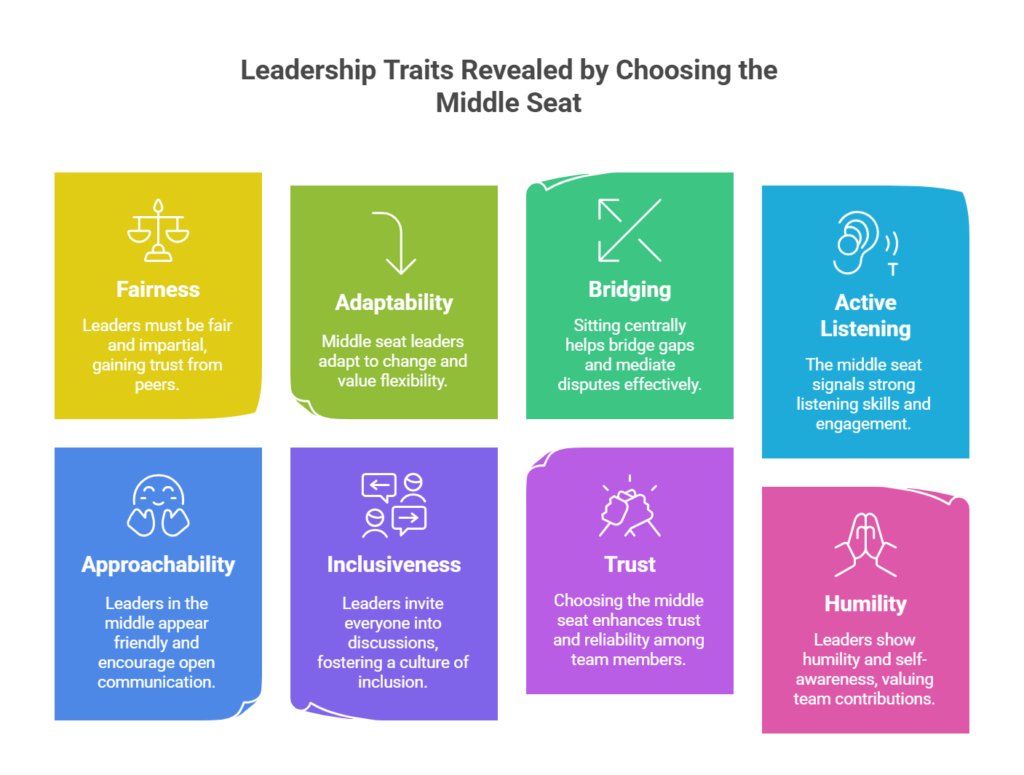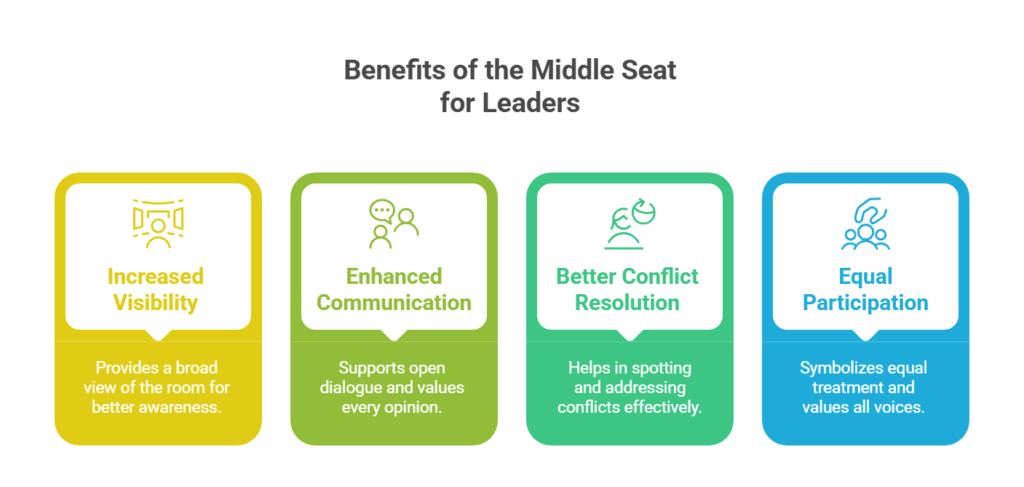Your seat in a meeting can reveal much about you. Choosing the middle seat is not random. It speaks of hidden traits that define your leadership. The middle seat sits between the front and the back. It is neither the leader’s seat nor the back-row spot. It is a neutral space that many overlook. In meetings, your seat can say a lot about you. The middle seat shows balance. It signals that you prefer a role of mediation. You often sit in this spot by choice.
Research shows that seating position affects perceptions. Research shows that where you sit changes how others see you. A study in researchgate found that people at the head of a table were seen as leaders. Their position gave them more influence in discussions. This data boosts our view that your seat can reveal leadership traits. This article breaks down eight key insights.
The Psychology Behind Seating Choices
Your seat is a simple decision that carries weight. Experts say that seating choices hint at underlying values. Those who choose the middle seat tend to seek balance. They avoid extremes and show a willingness to bridge gaps.
A study from The Journal of Environmental Psychology found that sitting at the center of a group can make someone appear more engaged and trustworthy. People in central positions also tend to speak more and have greater social influence. They work well with both the front and the back groups. This finding supports the idea that seating reflects leadership style.
Leadership Traits Revealed by the Middle Seat
Choosing the middle seat reveals several leadership traits. These traits include fairness, adaptability, and the desire for open dialogue.

Fairness and Impartiality
Leaders must be fair. They must listen to all sides. The middle seat symbolizes balance. It shows that you do not favor one group over another. This choice makes you appear impartial. You gain trust from your peers because you sit in a spot that is seen as equal.
Adaptability and Flexibility
Middle seat leaders adapt to change. They sit where they can see most of the room. They are ready to respond to different viewpoints. This habit shows that you value flexibility. You are not fixed in one role. Your choice allows you to shift your focus quickly as the meeting flows.
Bridging and Mediation
Sitting in the center lets you bridge gaps. You are in the best spot to hear all ideas. This position helps you mediate disputes. You become a link between different parts of the group. Leaders who choose this spot often excel in conflict resolution.
Active Listening and Engagement
The middle seat can also signal strong listening skills. When you are in the center, you are more engaged. Your body language shows that you are alert. This posture makes others feel heard. Active listening is a key leadership trait that helps teams grow.
Approachability and Open Communication
Leaders in the middle appear more friendly. They sit where everyone can see and talk to them. They greet questions with a calm tone. Their clear speech and open body language build trust. Colleagues feel safe to share ideas. This trait helps strong teams work well.
Inclusiveness and Team Building
Leaders in the middle invite everyone into the discussion. They naturally draw people together. Their seat sends a clear message: every voice matters. This approach builds a culture of inclusion. Team members feel valued and heard. Such behavior builds stronger, more united groups.
Trust and Reliability
Choosing the middle seat can make you seem trustworthy. Leaders in the center show that they value every team member’s input. Their presence is open and clear. This visibility makes them appear fair and reliable. When a leader is trusted, the team works better together. Trust is key to a strong team.
Humility and Self-Awareness
Leaders in the middle often show true humility. They sit where they can learn from others. They do not see themselves as above the team. Instead, they view themselves as part of a whole. Humility and self-awareness let them admit mistakes and grow. A humble leader listens first and then speaks. This earns respect and builds strong teams.
Expert Opinions and Data
A study from Northwestern University’s Kellogg School of Management found that seating arrangements affect group interactions. Sitting in a central spot makes it easier to contribute and be seen as a leader.
Studies on seating arrangements in meetings have underlined the significance of central seats in groups. For instance, research has identified that group members seated centrally tend to become leaders as a result of increased participation and facilitation of group interactions.
Benefits of the Middle Seat for Leaders
The middle seat offers several benefits. These benefits boost your leadership image and enhance your role in meetings.

Increased Visibility
The middle seat gives you a clear view of the room. You can see all sides at once. This broad view lets you catch non-verbal cues. It helps you understand group dynamics. Leaders who are aware of the room can guide the meeting better.
Enhanced Communication
Sitting in the center supports open dialogue. You are positioned to talk with everyone. Your voice carries evenly across the room. This position shows that you value every opinion. It encourages a free flow of ideas. Communication is the heart of good leadership.
Better Conflict Resolution
Leaders in the middle are often better mediators. They can spot conflicts early. Their central position lets them address issues as they arise. This ability to resolve conflicts makes your team stronger. It shows that you can handle challenges with calm and fairness.
Equal Participation
The middle seat is a symbol of equal treatment. It shows that you do not favor any one group. This choice makes team members feel valued. They know that their voice matters. Such an environment leads to better collaboration and teamwork.
Drawbacks and Considerations
While the middle seat has many benefits, it is not without challenges. Being in the middle can sometimes lead to distractions. You may be pulled in many directions. The constant flow of conversation can be hard to manage.
Risk of Overload
When you sit in the center, you receive input from all sides. This can sometimes feel overwhelming. Leaders must learn to filter the noise. They need to focus on key points. Without clear focus, the benefit of the middle seat may lessen.
The Pressure of Balance
The middle seat comes with high expectations. You must be neutral and fair. This pressure can lead to stress. Leaders must balance many views at once. It requires skill and calm under pressure. A leader in the middle must work hard to keep balance.
Avoiding Over-Participation
Sometimes, middle seat leaders risk talking too much. They may try to control every discussion. This can backfire. True leadership is about listening. Over-participation can silence others. Leaders must ensure that every voice is heard.
How to Make the Most of the Middle Seat
Leaders who choose the middle seat can maximize its benefits. Here are some steps to help you use your seat to boost your leadership style.
Practice Active Listening
Focus on what others say. Let each person share their view. Use your central position to observe body language. Active listening builds trust. It shows that you value input from all sides.
Stay Neutral
Avoid taking sides in conflicts. Keep your opinions balanced. Show that you understand every view. Neutrality earns respect. It also makes it easier to resolve disputes.
Manage Information Flow
Filter the input you receive. Focus on key ideas. Do not try to process every word at once. Use your middle seat position to gather important points. Then, share clear summaries with the group.
Encourage Open Dialogue
Ask questions and invite feedback. Use your seat as a bridge between team members. Make sure everyone feels included. A leader who fosters open dialogue builds a strong team. This approach leads to better decisions and stronger bonds.
Lead by Example
Show your team how to handle conflicts. Admit your mistakes when they occur. Use your middle seat to share ideas and build trust. Leadership is best shown through actions. Your behavior in meetings sets the tone for the group.
Final Thoughts
Choosing the middle seat is more than a random act. It speaks of balance, fairness, and a desire for open dialogue. Leaders who sit in the middle show that they value every team member. They are open, fair, and ready to mediate.
This choice sends a strong signal about how you lead. It can boost your influence in meetings. It builds trust and drives better teamwork. With the right approach, the middle seat can be a tool for growth. It reflects a leadership style that values balance and clear communication.
Use the tips and data in this article to refine your style. Own your role and set the stage for strong, effective meetings. Your seating choice is a simple act with a big impact. It shows that you are a leader who listens and guides. Embrace the middle seat and let it speak to your strengths.
Research & Study Links used in this article-
- Seating and Leadership Perception – ResearchGate
- Seating and Social Influence – Journal of Environmental Psychology
- Seating and Group Dynamics – Kellogg School of Management
- Seating arrangement and leadership emergence- semanticscholar.org







